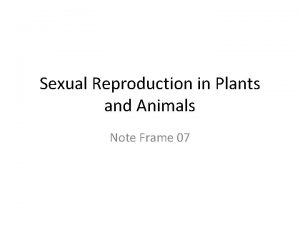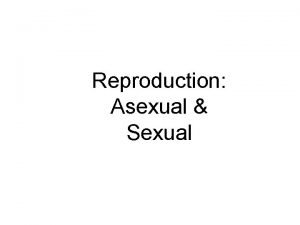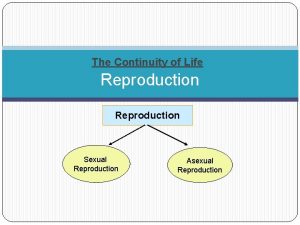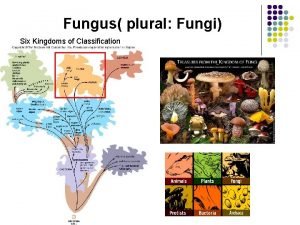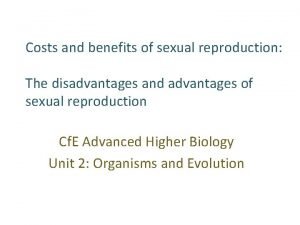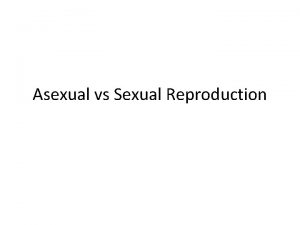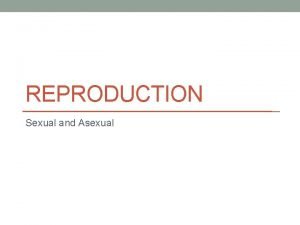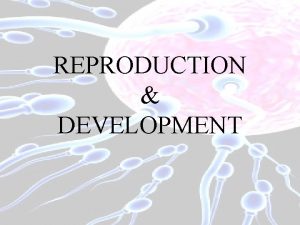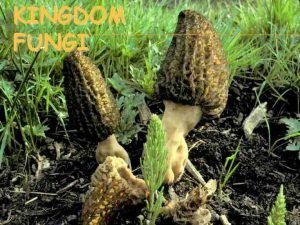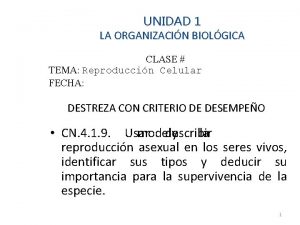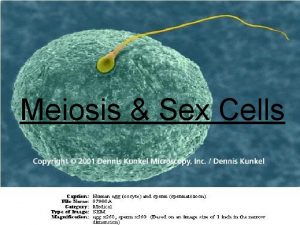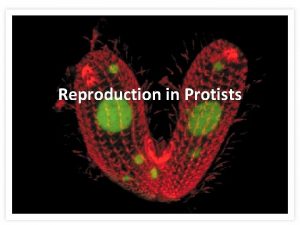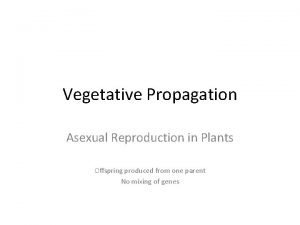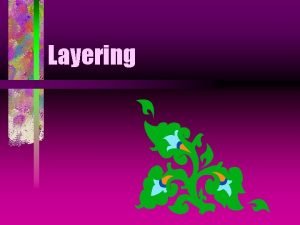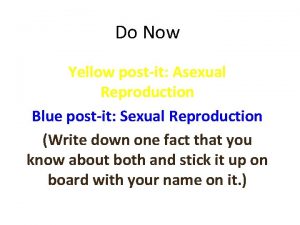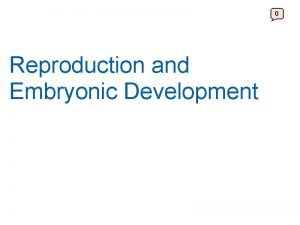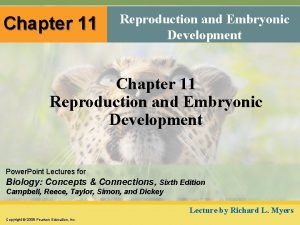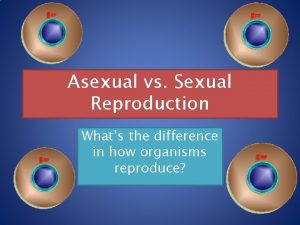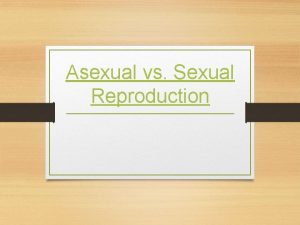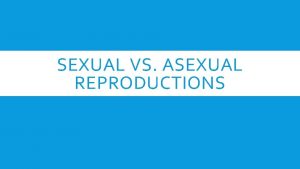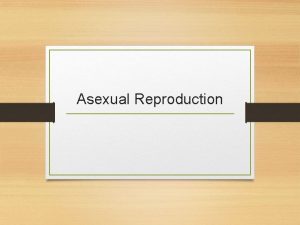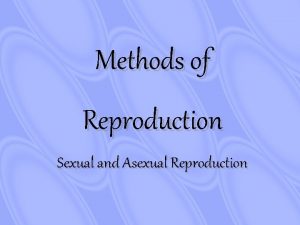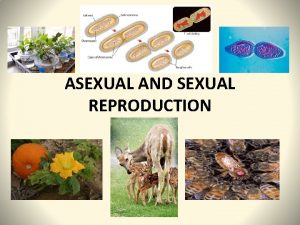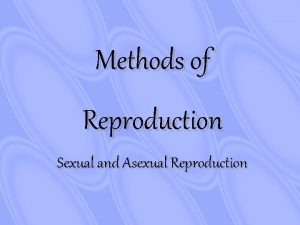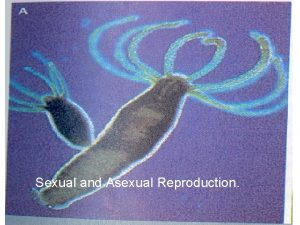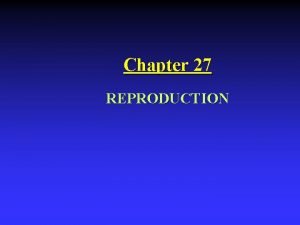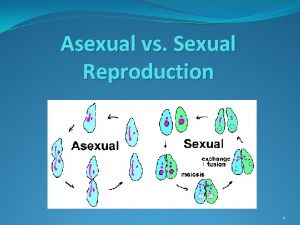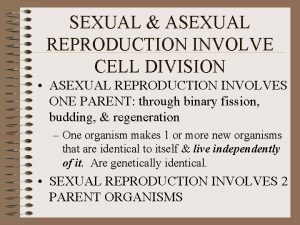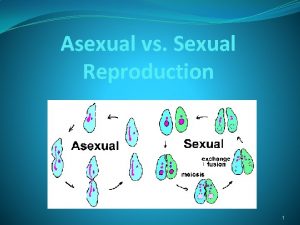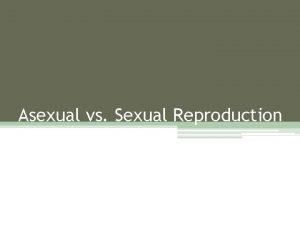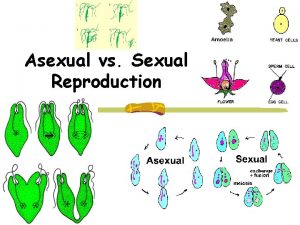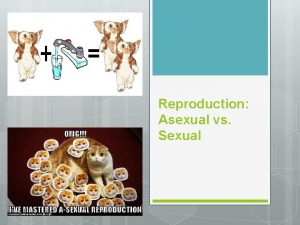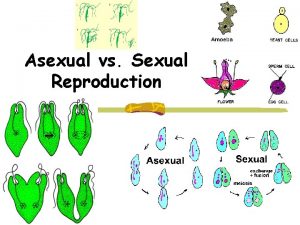REPRODUCTION Sexual and Asexual Reproduction the process of






























- Slides: 30

REPRODUCTION Sexual and Asexual

Reproduction – the process of living things producing the same type of living thing. Examples – horses produce horses, humans produce humans, and tomato plants produce tomatoes. * Like produces like. There are two types of reproduction: asexual and sexual

Asexual Reproduction Living things that reproduce from only one parent. Examples: Regeneration, budding, and cellular division.

Advantages of Asexual Reproduction: • animals that live in one place & unable to look for mates reproduce asexually. • numerous offspring can be produced without a great amount of energy or time. • One single organism can start new colonies in new locations. • Mating partners are not needed to be found. • More reliable (less to go wrong in cell division)

Disadvantages of Asexual Reproduction: • Species may not be able to adapt to a changing environment

Regeneration

Regeneration (before)

Regeneration (after)

Crown of Thorns Story

Regeneration (ex. starfish)

Can humans regenerate body parts by asexual reproduction?

Regeneration (ex. Planaria)

Budding (ex: Hydra)

Cellular Division (also called Binary Fission) • Protozoa

Binary Fission (ex. paramecium)

Binary Fission (ex. bacteria)

Asexual Reproduction in Plants • Propagation-transplanting parts of a plant to a new growing area (ex. Rhizomes, runners, bulb formation, rooting from stems) • Budding-tiny bud growing off parent plant (ex. Potato “eyes”, branches budding) • Spores-reproductive cells that produce a new organism (ex. Ferns, mushrooms, molds)

Propagation

Plant Budding

Spores

Sexual Reproduction Sexual reproduction usually requires two parents (partners). Examples: frogs, deer, bats, humans, and flowers.

Surinam Toad • http: //www. youtube. com/watch? v=m. Z 7 b 4 spj. Xhw

Advantages of Sexual Reproduction: • The offspring will be different than its parents. This allows the species to adapt to its surroundings.

Galapagos Finches • http: //www. youtube. com/watch? v=l 25 MBq 8 T 77 w

Disadvantages of Sexual Reproduction: • Often slower than asexual reproduction, and less reliable (more mutations, problems) • Much energy is used in mating processes • http: //videos. howstuffworks. com/animal-planet/28366 -fooled-by-nature-bowerbirds-seduction-video. htm • Can’t always find suitable mate

TWO TYPES OF REPRODUCTION • 1. Internal Fertilization • 2. External Fertilization

Internal Fertilization • Conjugation- Sexual reproduction between microscopic organisms Asexual budding

External Fertilization • Sex cells are dispersed out of the body in water • Examples: fish, salamanders, jellyfish

Meiosis • Produces sex cells only (sperm or egg cells) • Takes place in the reproductive organs of organisms that reproduce sexually.

 Hare lynx
Hare lynx Sexual reproduction vs asexual reproduction venn diagram
Sexual reproduction vs asexual reproduction venn diagram Venn diagram asexual vs sexual reproduction
Venn diagram asexual vs sexual reproduction Synapsis and crossing over
Synapsis and crossing over Animal chromosome number
Animal chromosome number Sexual and asexual reproduction in animals venn diagram
Sexual and asexual reproduction in animals venn diagram Is mitosis asexual
Is mitosis asexual Example sexual reproduction
Example sexual reproduction Asexual and sexual reproduction difference
Asexual and sexual reproduction difference Parthenogenesis
Parthenogenesis Example of asexual
Example of asexual Advantages of genetic diversity
Advantages of genetic diversity Sexual or asexual reproduction
Sexual or asexual reproduction Fungi plural form
Fungi plural form Disadvantage of sexual reproduction
Disadvantage of sexual reproduction Sexual or asexual reproduction
Sexual or asexual reproduction Sexual reproduction
Sexual reproduction Asexual or sexual reproduction
Asexual or sexual reproduction What are the characteristics of fungi
What are the characteristics of fungi Etapas de la reproducción humana
Etapas de la reproducción humana Sex cells
Sex cells How do protists reproduce
How do protists reproduce Dahlia asexual reproduction
Dahlia asexual reproduction Examples of asexual reproduction
Examples of asexual reproduction Asexual reproduction of flatworms
Asexual reproduction of flatworms Asexual propagation layering
Asexual propagation layering Type of sexual reproduction
Type of sexual reproduction Asexual reproduction
Asexual reproduction Asexual reproduction
Asexual reproduction Whats sexual reproduction
Whats sexual reproduction Chapter 19 asexual reproduction
Chapter 19 asexual reproduction








